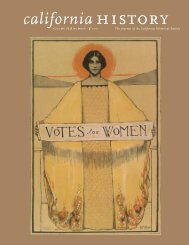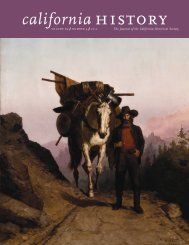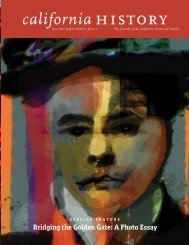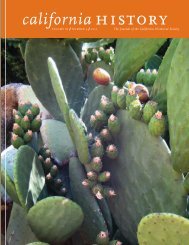Volume 90, Number 1 - California Historical Society
Volume 90, Number 1 - California Historical Society
Volume 90, Number 1 - California Historical Society
Create successful ePaper yourself
Turn your PDF publications into a flip-book with our unique Google optimized e-Paper software.
Monthly, marveled at the cultural attainments<br />
of these young Asians, who “talked freely” of<br />
“Emerson, Wordsworth, Longfellow, of Shakespeare”<br />
and also of Bunyan, “Victor Hugo, Walt<br />
Whitman, and even Bernard Shaw.” In addition,<br />
they were more versed in Russian literature than<br />
were their American equivalents. 50<br />
In contrast to the passing students, the Japanese<br />
live/work servants were indispensable to the<br />
Hights’s operation. Speaking to a reporter in the<br />
spring of 1895, Margaret Miller referred to the<br />
“two young Japanese” who had been “living with<br />
us here for a long time receiving instruction in<br />
English from Joaquin.” A more accurate description<br />
of the pedagogy would be Miller’s encapsulation<br />
of his relationship with Yone Noguchi, who<br />
arrived in the spring of 1895 and stayed for five<br />
years: “This boy is the right sort; he does just as<br />
he pleases—lives in the cabin yonder. I never go<br />
into it. Sometimes he comes in here and we talk<br />
of men and books.” 51<br />
Although honored to be at the famed Hights,<br />
Noguchi and his peers were essentially houseboys.<br />
However, unlike their comrades elsewhere,<br />
they received no compensation (Noguchi stated<br />
that the only object he received from his host<br />
were two pairs of woolen socks to replace his<br />
tattered ones). 52 A revealing photo (page 56)<br />
of Miller with three Japanese youths and two<br />
horses (unusual among archival photos of casual<br />
scenes in that it bears a specific date, June 6,<br />
1891) gives a sense of their status. In this image,<br />
the poet is every bit the proud ranch owner. One<br />
arm is tossed casually over his horse. Two of<br />
the Japanese hold the horses. A third looks out<br />
shyly from behind Miller. The front steps of the<br />
Abbey appear to the right and in the distance are<br />
a lordly view of Fruitvale’s eponymous orchards<br />
and a snatch of County Road #2509. The “fruit<br />
grower and poet,” as he had once again listed<br />
himself in the local directory, is showing off his<br />
steeds, his servants, and his domain. 53<br />
In 1893, student-laborer Yonejiro (Yone) Noguchi (1875–1947)<br />
took up residence at the Hights, where he began his English literary<br />
career and embarked, in 1897, on a correspondence with<br />
Charles Warren Stoddard. This autographed portrait, made on<br />
July 4, 1897, was one of three he sent to Stoddard, each posed in<br />
western rather than Japanese dress, a preference acknowledged<br />
by Miller during Noguchi’s almost decades-long residence in the<br />
United States. Noguchi, Miller explained to the San Francisco<br />
Chronicle, “objects to that sort of interest, saying that he wants<br />
to write for America, and depend solely on the value of his<br />
work.”<br />
Courtesy of the Huntington Library, San Marino, <strong>California</strong><br />
The following year brought Takeshi Kanno, the<br />
longest, most continuous Japanese inhabitant.<br />
A self-styled philosopher, Kanno was to become<br />
embroiled in two scandals: his interracial marriage<br />
to the sculptress Gertrude Boyle and her<br />
desertion of him for one of his much younger<br />
countrymen. This regrettable fate, including his<br />
eventual remarriage with Boyle, has not been<br />
sufficient to win lasting fame for the luckless<br />
Kanno. 54<br />
55









